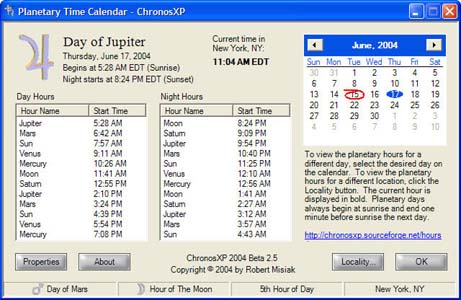The planetary hours are based on an ancient astrological system, the Chaldean order of the planets. This is the sequence: Saturn, Jupiter, Mars, Sun, Venus, Mercury, Moon, then repeating endlessly Saturn, Jupiter, etc. The Chaldean order indicates the relative orbital velocity of the planets. From a heliocentric perspective this sequence also indicates the relative distance of the planets from the center of their orbits, i.e., the distance of the planets from the Sun (with the Sun switching places with the Earth in the sequence) and the distance of the Moon from the Earth. From a traditional geocentric perspective the Chaldean order also shows the arrangement of the planetary spheres.
The planetary hours use the Chaldean order to divide time. Each planetary hour of the planetary day is ruled by a different planet. The planet that rules the first hour of the day is also the ruler of the whole day and gives the day its name. Thus the first hour of Sunday is ruled by the Sun, the first hour of Monday is ruled by the Moon and so on.
However, the planetary hours are not the same as the sixty minute hours beginning at midnight that we use for normal timekeeping. The planetary days are divided into twenty four planetary hours with the first hour of the day beginning at sunrise and the last hour of the day ending at sunrise of the next planetary day. The period that extends from sunrise to sunset (daylight) is divided into twelve hours and the period extending from sunset to sunrise of the next day (nighttime) is also divided into twelve hours giving the twenty four hours of the planetary day.
Het geeft dus de tijd hier op aarde weer maar dan in bovenstaand formaat. Dus als je eens wat anders wilt dan 12:32 dan kan je hier dus voorkiezen.
Installer (325KB)
Installer + MS.NET (22.792KB)
Source (307KB)


:strip_exif()/i/1087905347.jpg?f=thumbmedium)